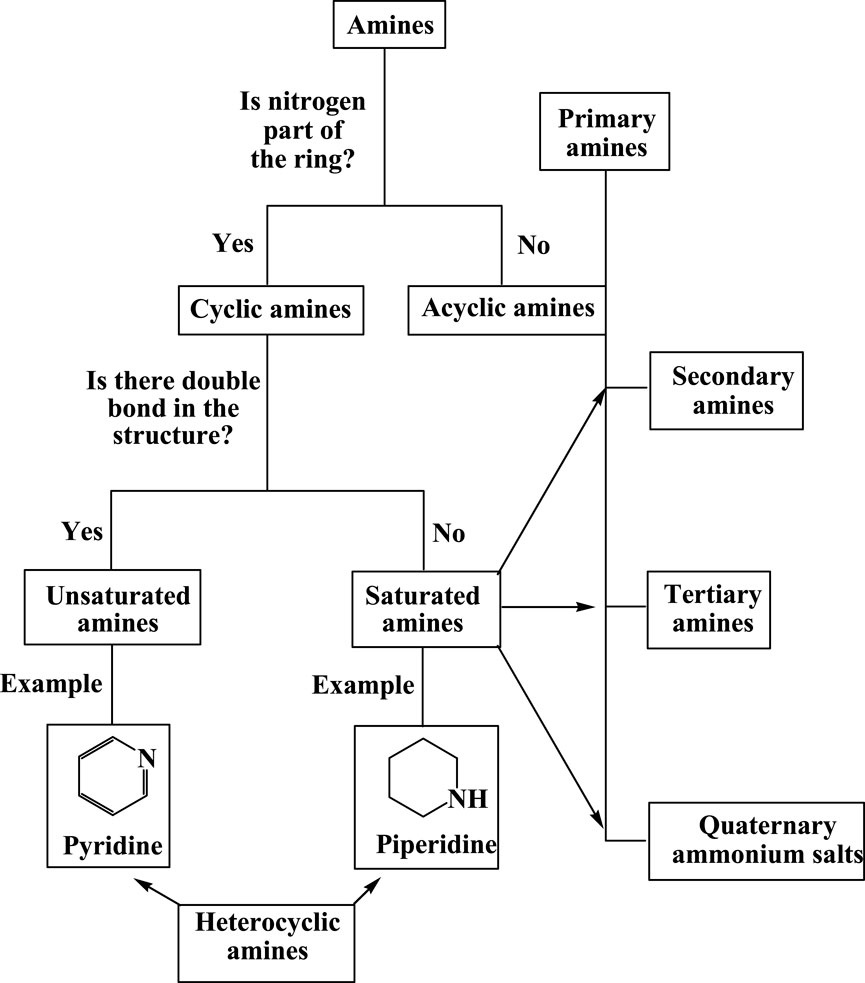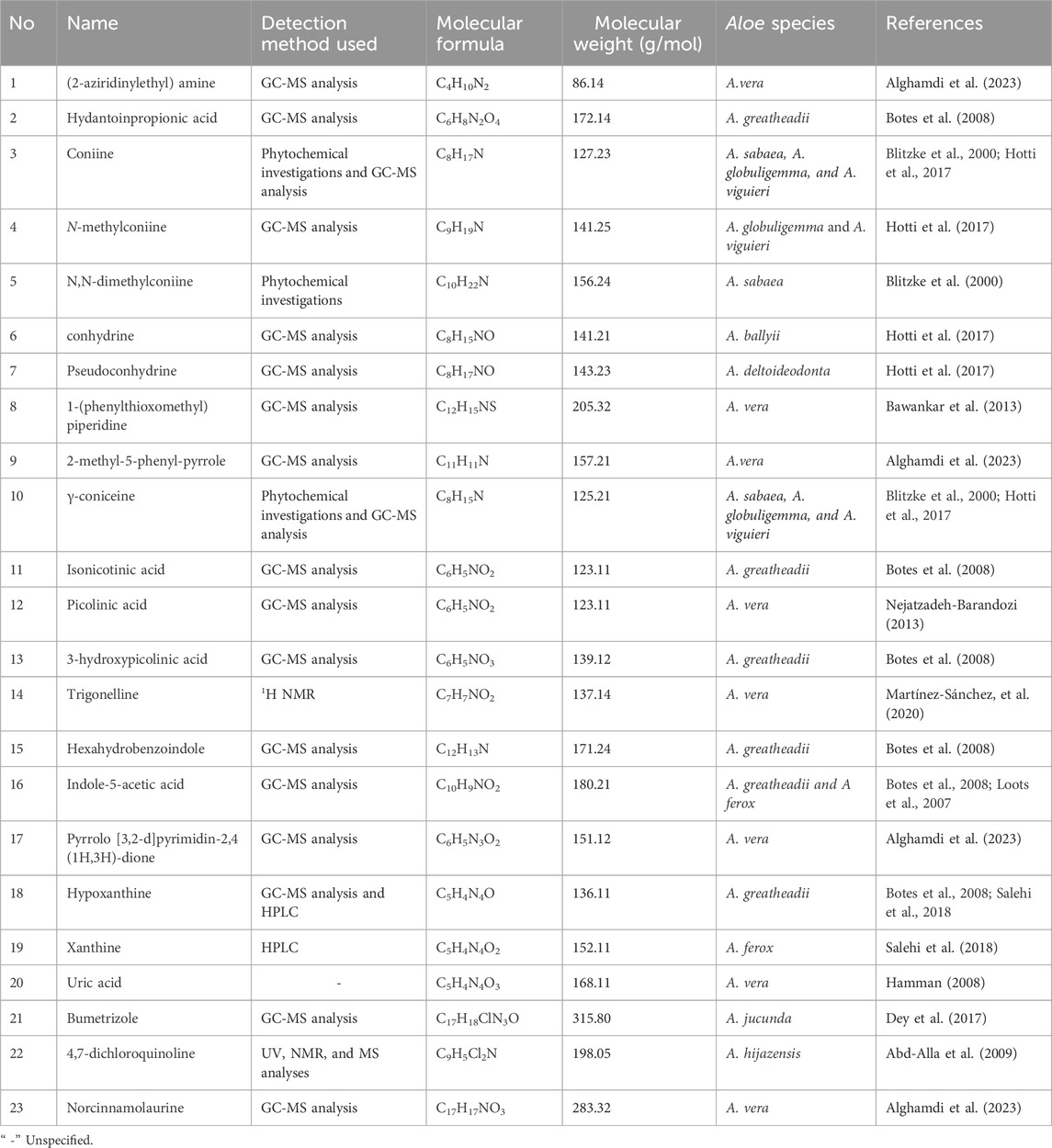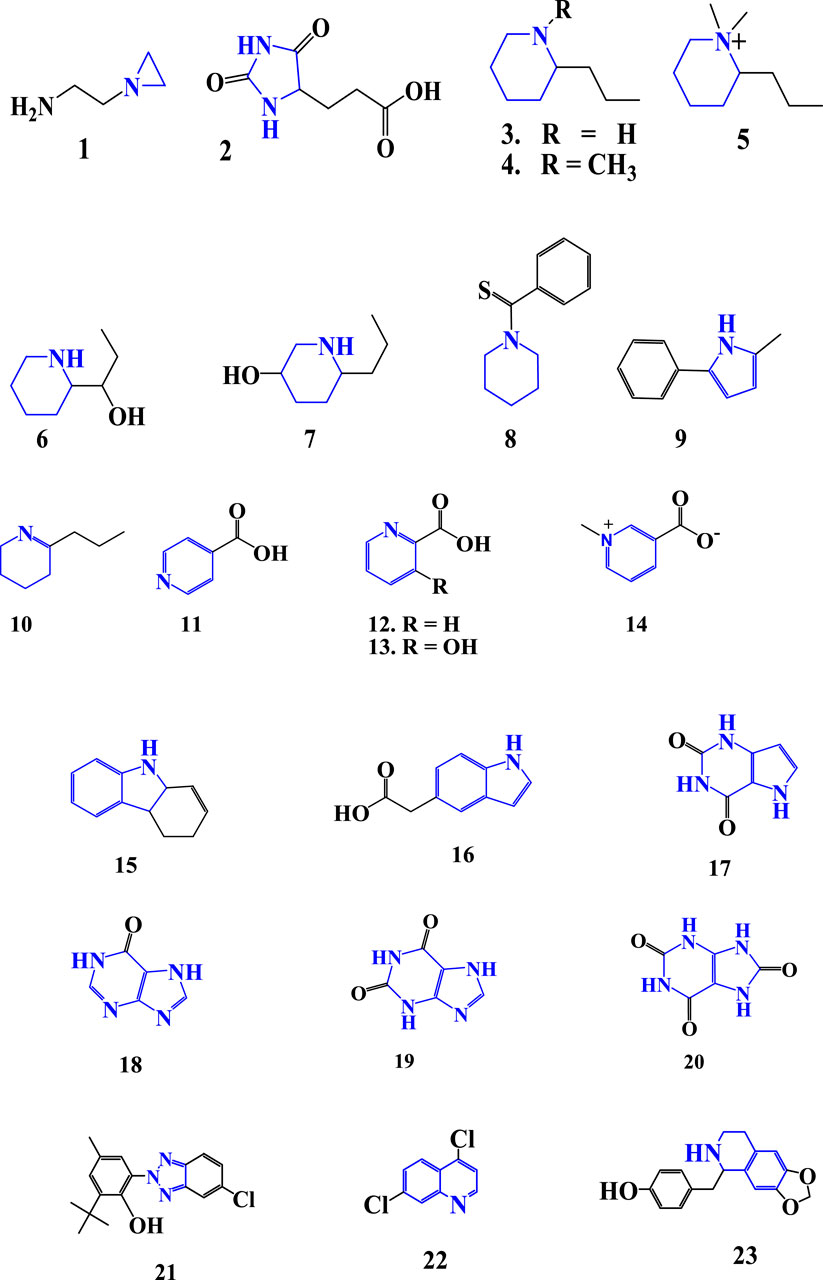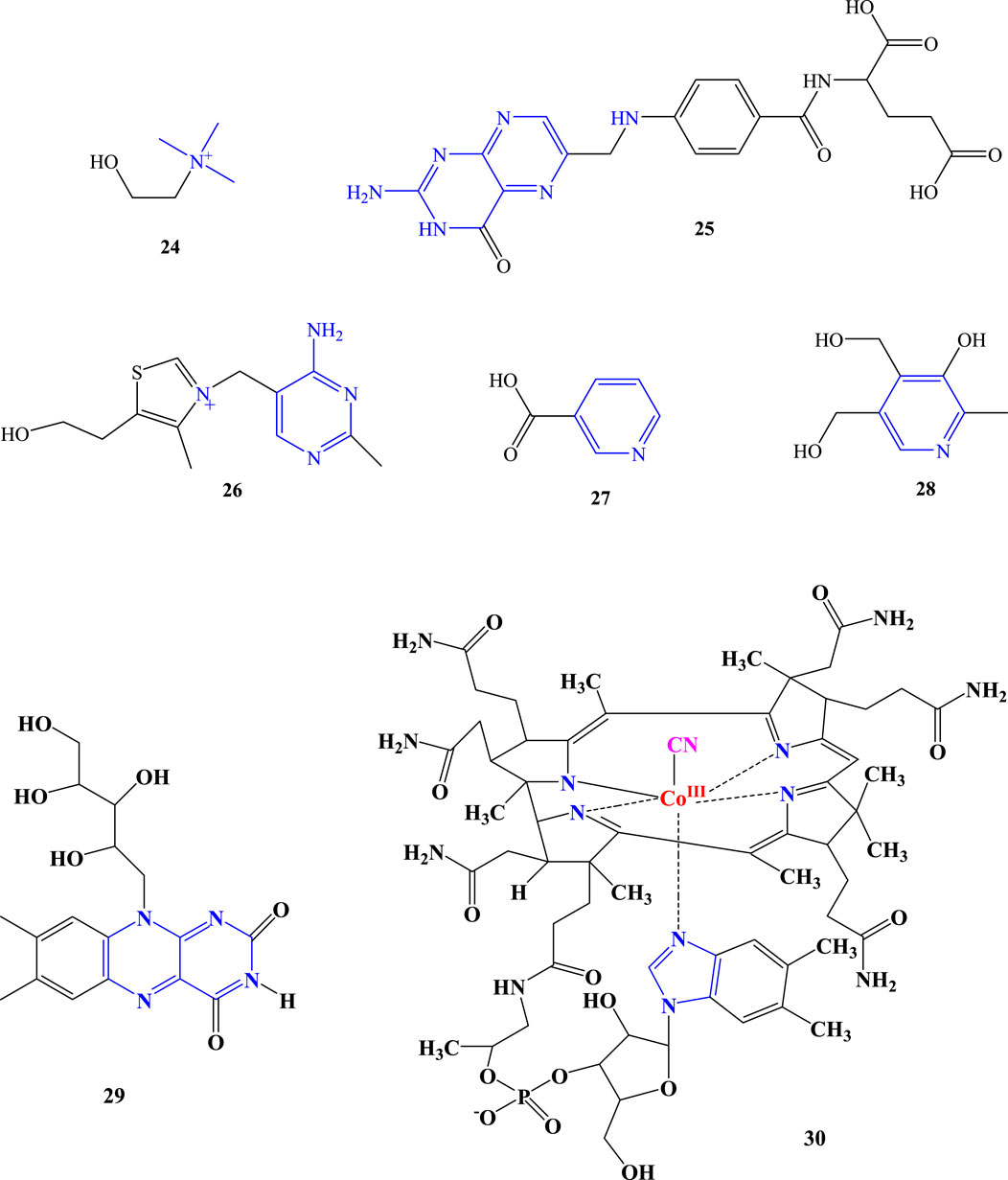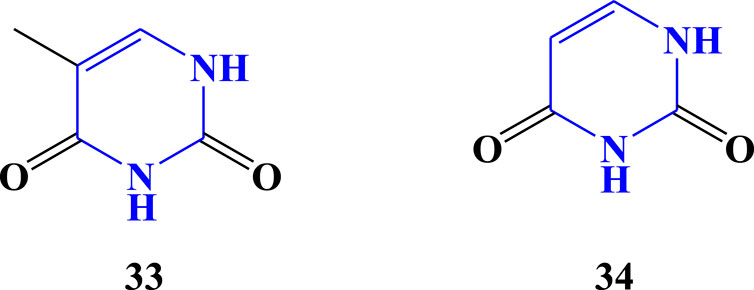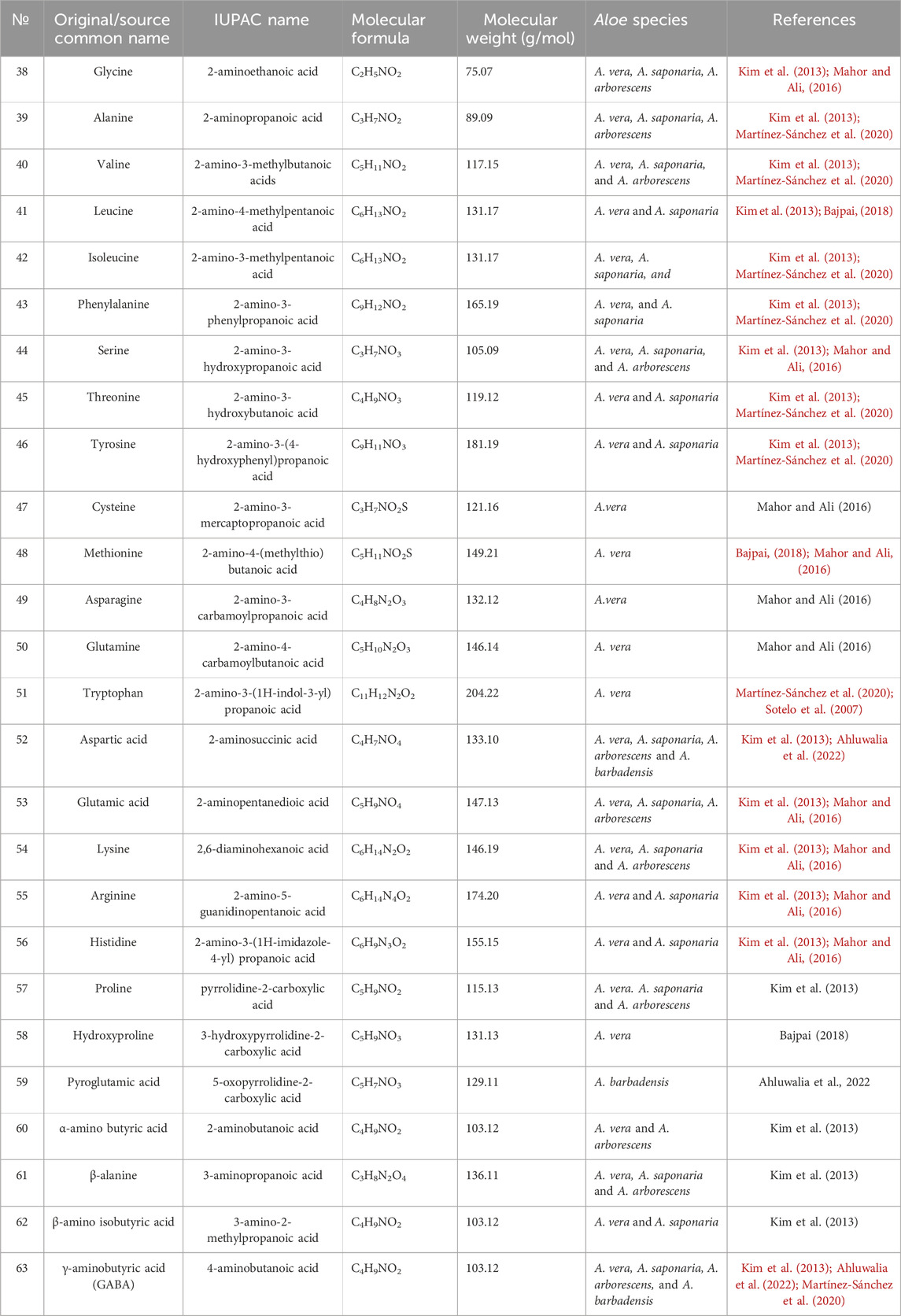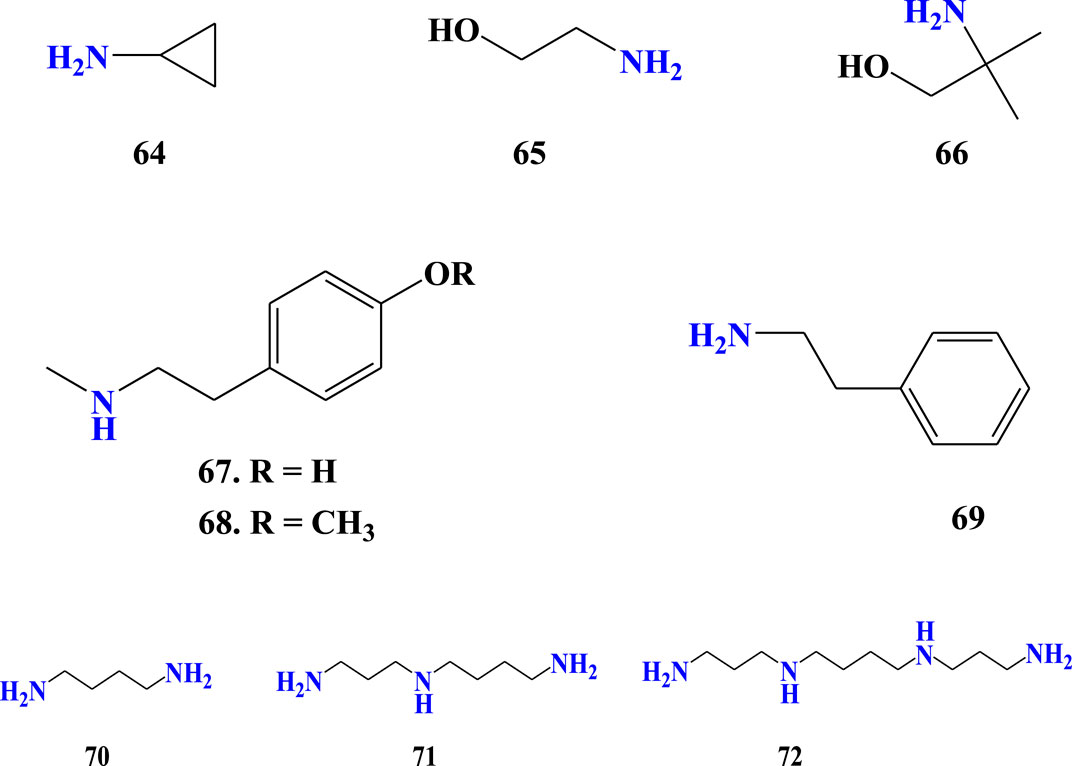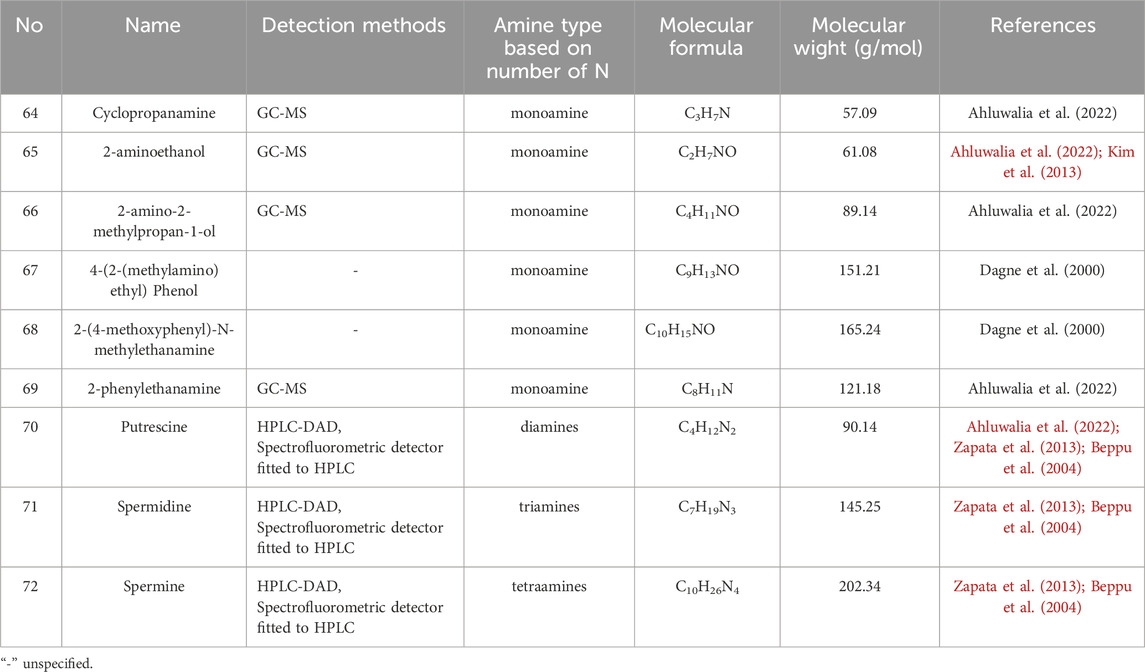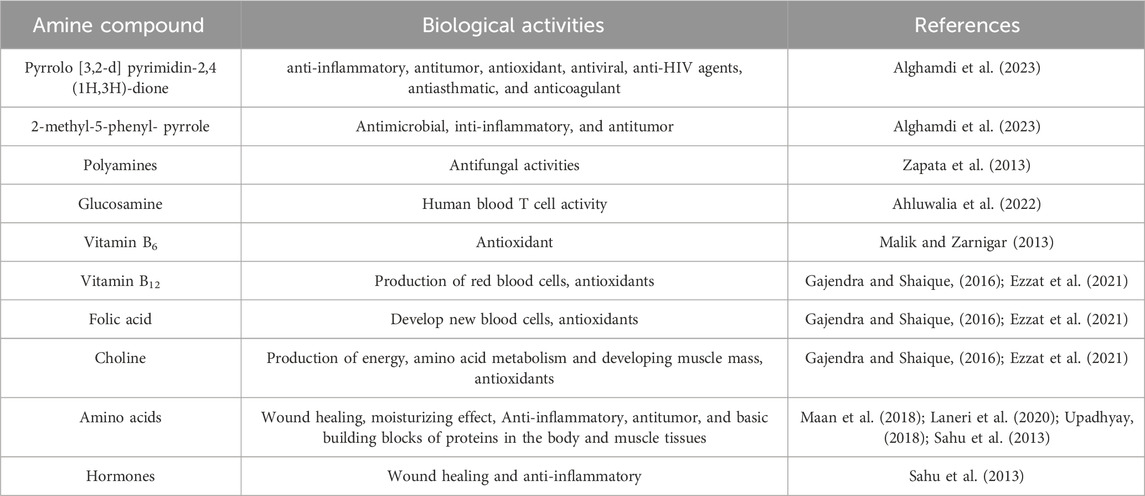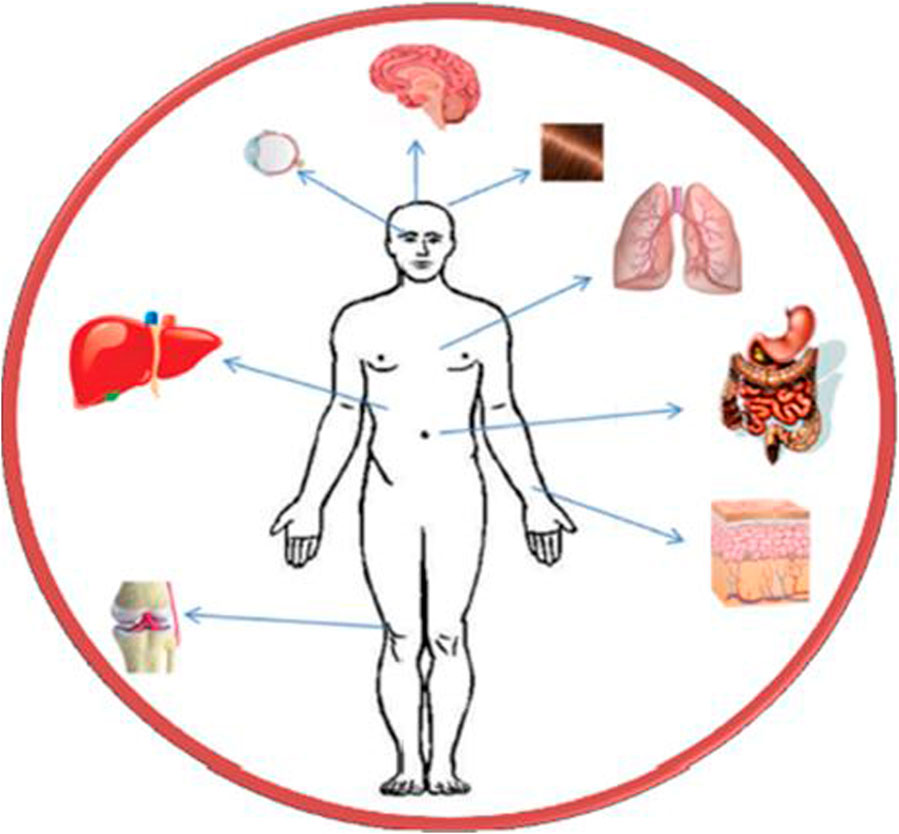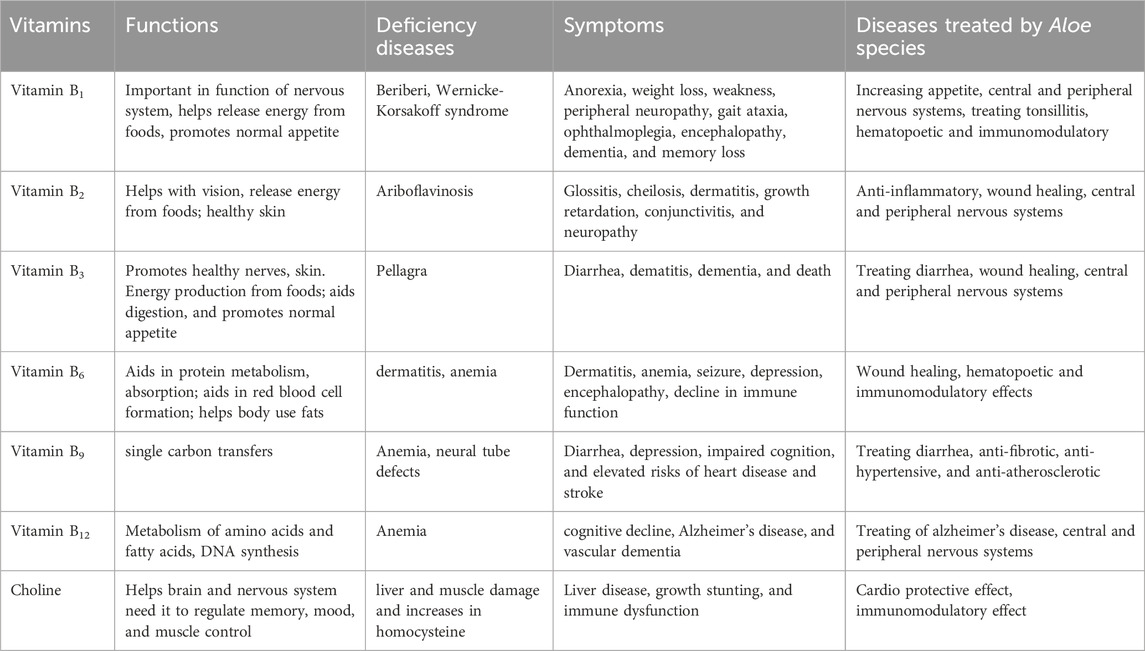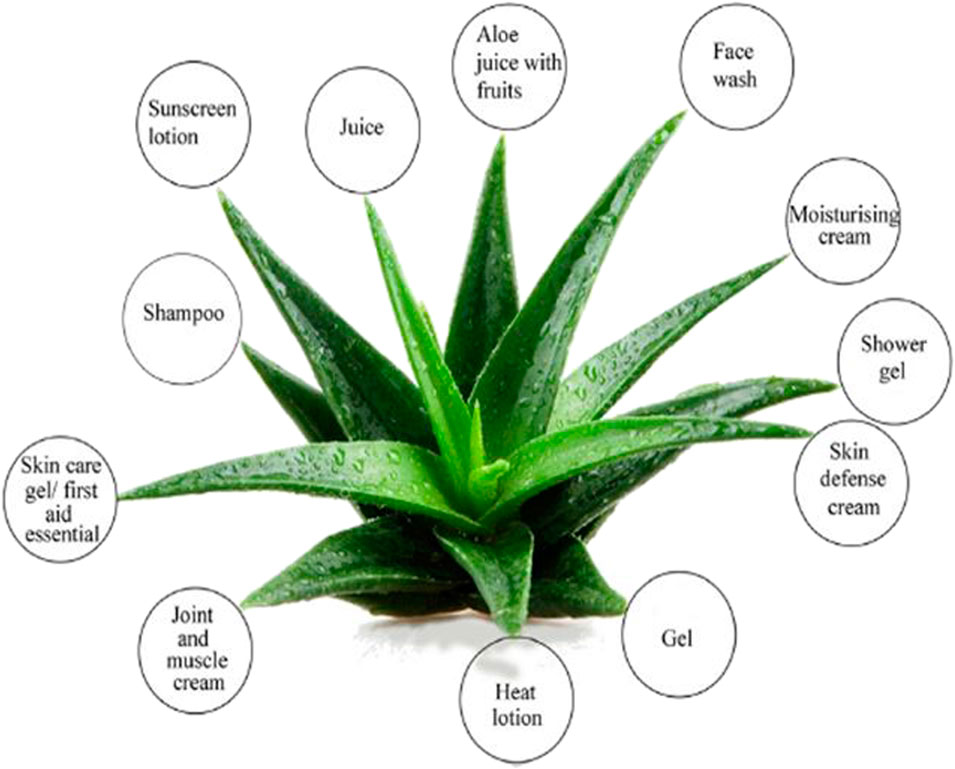- Department of Chemistry, College of Natural and Computational Sciences, Mekdela Amba University, Tulu Awuliya, Ethiopia
Unrestricted interest in Aloe species has grown rapidly, and a lot of research is currently being done to learn more about the properties of the various Aloe constituents. Organic compounds containing amine as functional group are present in a vivid variety of compounds, namely, amino acids, hormones, neurotransmitters, DNA, alkaloids, dyes, etc. These compounds have amine functional groups that have various biological activities, which make them responsible for medicinal potential in the form of pharmaceutical, nutraceutical, and cosmeceutical applications. Consequently, the present review work provides an indication of the amines investigated in Aloe species and their therapeutic uses. Various amine compounds of the Aloe species have effective biological properties to treat diseases. Generally, the genus Aloe has various active amine-containing compounds to combat diseases when humans use them in various forms.
1 Introduction
Unrestricted interest in Aloe species has grown rapidly and a lot of research is currently being done to learn more about the properties of the various Aloe constituents (Singab et al., 2015). Aloe plants are a unique source of phytochemicals because they can tolerate hot, dry weather. As a result, they store water and vital chemical components in their swollen, succulent leaves (Wójcik et al., 2021). Numerous studies conducted both in vitro and in vivo have confirmed the biological properties of Aloe species, including wound healing, anti-tumoral, anti-inflammatory, antimicrobial, antimalarial, anticancer, etc. properties. Mostly, these characteristics could not be ascribed to a single class of compounds, but rather to a variety of compounds found in the phytochemical profile of Aloe extracts (Hamman, 2008; Sharrif Moghaddasi and Res, 2011; Andrea et al., 2020). Alkaloids, amino acids, vitamins, hormones, proteins, polyphenols, saccharides, organic acids, and other naturally occurring phytochemicals are abundant in Aloe species (Zayed et al., 2012; Ufnal et al., 2015; Sánchez et al., 2020). Most of these phytochemicals have the functional group amine. Amines are present in large amounts in all living things (Kaur et al., 2018).
Amines are nitrogen-containing functional groups of organic chemistry that arise from the substitution of an alkyl or aryl group for one or more hydrogen atoms in ammonia (NH3) (Lawrence, 2004). Amines are categorized as primary (RNH2), secondary (R2NH), or tertiary (R3N) depending on whether one, two, or three of the hydrogen atoms in ammonia have been substituted out for organic groups (Graton et al., 2005). Quaternary ammonium compounds fall into a fourth category. They are created by substituting all four hydrogen atoms in the ammonium ion, NH4+; an anion (R4N+X−) is required in this case (Grossman and Grossman, 2003). When nitrogen is part of the ring, the compound is known as heterocyclic amine; each heterocyclic ring system has a unique parent name. Always, the nitrogen atom is assigned to position 1 in heterocyclic amines (Jacobi, 2018). Compounds such as pyridine, pyrrole, quinoline, imidazole, indole, pyrimidine, pyrrolidine, and piperidine are examples of commonly known heterocyclic amines. These amines are used as parent names for their substituents (Li, 2013). Generally, amines have two broad categories: cyclic amines and acyclic amines. Cyclic amines are heterocyclic amines that have one or more nitrogen as heteroatoms. Heterocyclic amines have no primary amines due to their rings. Cyclic amines are further classified into saturated and unsaturated amines. Unsaturated amines which have C_N double bonds cannot be primary, secondary, etc. In another way, acyclic amines have nitrogen out of the ring. Moreover, any amine falls into the categories of heterocyclic amine, primary amine, secondary amine, tertiary amine, or quaternary ammonium salt (Figure 1).
Organic compounds containing amine as functional group are present in a vivid variety of compounds, namely, amino acids, hormones, neurotransmitters, DNA, alkaloids, dyes, etc. Drugs such as morphine, nicotine, codeine, and heroin, etc., that have physiological properties in humans also contain amino groups in one form or another. Amines are basic because of the presence of a lone pair of electrons on nitrogen (El-Sakka, 2010; Otimenyin, 2022). Amine-containing compounds have unique properties that make them biologically active molecules. A lone pair of electrons on nitrogen dominates the chemistry of amines, making them both bases and nucleophiles (Morgenthaler et al., 2007; Vedejs and Denmark, 2016). Due to these properties, the compounds that have amine functional groups have various biological activities that are responsible for pharmaceutical, nutraceutical, and cosmeceutical applications. Using amines for a variety of applications needs attention currently. However, to the best of my knowledge, no comprehensive work was done regarding the amine-containing compounds detected in the Aloe species for their medicinal potential. Consequently, the present work summarizes amine-containing compounds investigated from Aloe species and their therapeutic uses. More generally, the core point of the current review is to describe the chemical structure of the detected amine compounds from Aloe species and relate them to the studied medicinal activities of the plants.
2 The review methodology
The relevant sources for this study were retrieved using search engines including Google Scholar, PubMed, and Science Direct. For the purpose of finding relevant sources, several combinations of terms and phrases such as amines, alkaloids, amino acids, vitamins, hormones, Aloe species, Aloe species phytochemicals, Aloe species applications, and medicinal activities of Aloe extracts and compounds were utilized. This review covered studies on chemical structures of amines analyzed from Aloe species, the medicinal potential of Aloe extracts, and amine compounds. Reports on such activities based on other than amine compounds were excluded. Studies that were published in languages other than English were not at all taken into account. Following the collection of all sources, a rapid study of the sources’ titles, abstracts, and conclusions was done to determine which ones met the qualifying requirements. The chosen sources were then carefully examined in order to prepare this review paper. The chemical structures of the compounds were depicted using ChemDraw Ultra 8.0 software, while citations and checking references were provided using Mendeley Desktop software.
3 Structures of amines detected from Aloe species
3.1 Alkaloids
The name alkaloid (“alkali-like”) was originally applied to the substances because, like the inorganic alkalis, they react with acids to form salts (Alamgir, 2018). Alkaloids are small organic molecules that contain nitrogen, usually in a ring. Therefore, alkaloids are one of the heterocyclic amine compounds having nitrogen as a heteroatom (Bhardwaj et al., 2021). Alkaloids are an important group of biologically active amines that are mostly synthesized by plants to protect them from being eaten by insects and other animals. Alkaloids in nature are vast, so we need to classify them into specific groups. Compounds such as nucleosides, vitamins, hormones, some amino acids, etc. are alkaloids. For instance, pyridoxine is a vitamin as well as an alkaloid; proline is α-amino acid as well as an alkaloid. However, such compounds are together called amines (Wade, 2013; Mcmurry, 2016).
Alkaloids have been analyzed from Aloe species quantitatively and qualitatively (Sonam and Archana, 2016; Usman et al., 2020). Phytochemical screening showed the presence of alkaloids in various Aloe species such as A. adigratana, A. barbadensis, A. calidophila, A. ferox, A. vera, A. turkanensis, and A. Gilbertii from the leaves of plants such as gel, latex, skin, whole leaf (Salehi et al., 2018), roots (Jemal et al., 2018), and flowers (Martínez-Sánchez et al., 2020). Also, a number of alkaloid compounds have been isolated from Aloe species (Salehi et al., 2018). The detected alkaloids from the Aloe species are heterocyclic amines, and they are derivatives of the base heterocyclic amines (Table 1). The nomenclatures of some alkaloids were not copied directly from the names reported in the literature. Because some names of alkaloids are complex to write. For instance, the compound 23, which was obtained from GC-MS analysis of ethanolic extract A. vera was written in the literature as phenol, 4-[(5,6,7,8-tetrahydro-1,3-dioxolo [4,5-g]isoquinolin-5yl)methyl]. This name is too long; instead, ‘norcinnamolaurine’, the other name of the compound, was used in the current work (Table 1; Figure 2).
3.2 Vitamins
Vitamins are organic compounds required by humans as nutrients in small amounts known as micronutrients. They are very important compounds for the activities of enzyme cofactors and coenzymes. The term vitamin is derived from the Latin words ‘vital’ and ‘amine’, combined as “vital amines” or “vitamines”. The “e" at the end of “vitamine” was later removed when it was realized that vitamins need not be nitrogen-containing amines. Therefore, not all vitamins are amines (Menon et al., 2008; Miodownik and Lerner, 2010; Godswill et al., 2020). Among the vitamins detected from Aloe species are choline, folic acid (B9), vitamin B1 (thiamine), niacin (nicotinic acid, also known as vitamin B3), vitamin B2 (riboflavin), vitamin B6 (pyridoxine), and vitamin B12 (cyanocobalamin). Although vitamin B6 is a collective term for pyridoxine, pyridoxal, and pyridoxamine, pyridoxine occurs predominantly in plants, whereas pyridoxal and pyridoxamine are found in foods obtained from animals (Hellmann and Mooney, 2010; Dewangan and Bhatia, 2023). Therefore, the B6 detected in Aloe plants is pyridoxine (compound 28). Choline is not strictly a vitamin but is an essential nutritional quaternary ammonium salt form of amine. However, it is known in the literature by means of vitamin B4 (Rakkar and Hillier, 2007). In Aloe species, it has been reported as a vitamin. Being mostly studied and known by various names, A. vera is the species for which these vitamins are reported (Akaberi et al., 2016; Mahor and Ali, 2016; Maan et al., 2018; Pegu and Sharma, 2019; Martínez-Sánchez et al., 2020; Adlakha et al., 2022).
The majority of vitamin studies omitted information about the analytical techniques used to detect them. Munoz et al. (2015) have reported that the Association of Official Analytical Chemists (AOAC) is utilized for the purpose of detecting vitamins in A. vera. Furthermore, choline from A. vera has been detected using 1H NMR (Martínez-Sánchez et al., 2020). Since nitrogen is a structural component of all these vitamins, they are all amine compounds (Figure 3). Because of this nitrogen, the vitamin’s amines can be classified as primary, secondary, tertiary, quaternary ammonium salts, and/or heterocyclic amines (Table 2).
3.3 Hormones and neurotransmitters
Auxins are a group of naturally occurring plant hormones (Agboola et al., 2014), and they are one of the two hormones repeatedly reported from Aloe species such as A. vera (Hamman, 2008). In other studies, indole-3-acetic acid (Figure 4; Compound 31) was detected in A. vera (Nejatzadeh-Barandozi, 2013) and A ferox (Loots et al., 2007). This indole-3-acetic acid is one of the auxin compounds (Santos et al., 2021). However, the works of literature that reported the presence of auxins from Aloe species have not mentioned indole-3-acetic acid presence as well, and the literature that reported indole-3-acetic acid has not explained it as one of auxin hormones. Therefore, the current work combines the literature to clarify the auxin hormones present in the Aloe species in the form of indole-3-acetic acid. The newly reported amine-containing hormone from Aloe species is noradrenaline (32, Figure 4). It was analyzed from A. barbadensis Mill. (Ahluwalia et al., 2022). Noradrenaline, also called norepinephrine, is an organic chemical in the catecholamine family that functions in the brain and body as both a hormone and neurotransmitter (Savaliya and Georrge, 2020). Hence, it is important to understand the two amine hormones of Aloe species, both, namely, and structurally.
3.4 Nucleobases, nucleosides, and nucleotides
Nucleobases (nitrogenous bases or simply bases) are nitrogen-containing biological compounds that form nucleosides, which, in turn, are components of nucleotides, with all of these monomers constituting the basic building blocks of nucleic acids (Al-hayali, 2022). Among the five nucleobases, thymine and uracil (Figure 5) were detected in A. vera (Nejatzadeh-Barandozi, 2013), A. ferox (Loots et al., 2007), and A. greatheadii (Botes et al., 2008). These bases are pyrimidine bases because they are derived from pyrimidine. The main distinction between thymine (T) and uracil (U) lies in their chemical structure. Thymine (33) has a methyl group (CH3) attached to its ring structure, whereas uracil (34) does not have this methyl group. This structural difference is responsible for the various roles of thymine in DNA and uracil in RNA (Ono et al., 2011; Lippert and Sanz Miguel, 2016). In addition to nucleobases, nucleoside and nucleotide have been detected in Aloe species. Adenosine (nucleoside, 36) and adenosine monophosphate (nucleotide, 37) have been detected quantitatively from the flower of A. vera (Martínez-Sánchez et al., 2020).
3.5 Amino sugars and related amines
Amino sugars are chemical compounds with a sugar backbone where an amine group has taken the place of one of the hydroxyl groups (Parsons, 2021). Glucosamine (35) is an amino sugar and a prominent precursor in the biochemical synthesis of glycosylated proteins and lipids (Dalirfardouei et al., 2016). A sugar in which an amino group replaces the anomeric OH is called a glycosylamine. Adenosine (36) is glycosylamine, in which the amino component is a purine. The molecule consists of an adenine attached to a ribose via a β-N9-glycosidic bond. Adenosine is one of the four nucleoside building blocks of RNA (and its derivative, deoxyadenosine, is a building block of DNA), which are essential for all life on earth (Vázquez-Salazar et al., 2018; Rodrigues, 2021). A nucleotide consists of a sugar molecule (either ribose in RNA or deoxyribose in DNA) attached to a phosphate group and a nitrogen-containing base (Tripathi et al., 2023). Adenosine monophosphate (AMP), also known as 5′-adenylic acid, is a nucleotide. AMP (37) consists of a phosphate group, the sugar ribose, and the nucleobase adenine (Najeeb et al., 2023). Glucosamine, adenosine, and AMP have been detected in Aloe species (Martínez-Sánchez et al., 2020; Ahluwalia et al., 2022). These compounds have amine and sugar in their structure, which makes them similar to one another (Figure 6).
3.6 Amino acids
Amino acid is any of a group of organic molecules that consist of a basic amino group (NH2), an acidic carboxyl group (COOH), and an organic side chain (R group, unique to each amino acid) (Taniguchi, 2010). Amino acids are primary amines (Mcmurry, 2016). Amino acids are essential plant compounds serving as the building blocks of proteins, the predominant forms of nitrogen (N) distribution, and signaling molecules (Moe, 2013). The amino acids of Aloe plants have been reported by many authors in both quantitative and qualitative analyses. Although there are a number of methods to detect amino acids, many of the amino acids (Table 3) detected in Aloe species were using an amino acid analyzer equipped with an HPLC and UV detector (Kim et al., 2013; Chandra Sekhar Singh et al., 2018). In addition to that, HPLC and 1H NMR were used for the detection of amino acids in Aloe species (Hendrawati et al., 2019; Martínez-Sánchez et al., 2020). The analyzed amino acids from Aloe species are the twenty standard α-amino acids and their derivatives, which differ only in side chain (R) groups (Figure 7: structures 38–60). The noncyclic α-amino acids have an amino group in their C2, which ‘2-amino’ is common for all. In addition to α-amino acids, β-amino acids (61 and 62) and γ-amino acids (63) have been analyzed from Aloe species (Figure 7). Totally, the amino acids detected from Aloe species have been summarized in Table 3; Figure 7.
3.7 Other amines of Aloe species
Compounds 64–72 were reported from Aloe species (Figure 8). These compounds have a good sense if kept as amines rather than grouping them into other organic compounds such as alkloids. For instance, compounds (67) and (68) were reported as alkaloids from Aloe species (Dagne et al., 2000; Cock, 2015). The amine called 2-phenylethanamine (69) is a precursor for many compounds, including noradrenaline (Solomons, 2011), the hormone reported from A. barbadensis Mill. Regarding the amines detected from Aloe species, any amine may be monoamine or polyamine such as diamines, triamines, tetramines, or, etc., based on the number of nitrogens present in the structure (Table 4; Figure 8). Monoamines have one nitrogen in their structure, while polyamines have two or more ntrogens in their structures. The quantities of putresine, spermidine, and spermine polyamines have been analyzed from the leaf gels of A. arborescens Mill., A. aristata Haw., A. claviflora Str., A. ferox Mill., A. mitriformis Mill., A. saponaria Ait., A. striata Haw., and A. vera L, A. barbadensis Mill. (Beppu et al., 2004; Zapata et al., 2013; Ahluwalia et al., 2022). These polyamines have biochemical relationships. They also have specific odors, which make amines have unique odors, such as rotting fish. For instance, 1,4-butanediamine (71) has the appalling odors that might be expected from its common name, ‘putrescine’ derived from odor. Biologically, putrescine is synthesised from the catabolism of proteins (Mcmurry, 2016).
4 Biological activities of Aloe amines
Traditionally, people use various parts of Aloe species such as leaf gel, leaf latex, fresh leaf, root, flowers, etc. solely or by incorporating them into other substances for impotency in men, wounds, malaria, ticks, bloat and fire burn, caught, stomach ache, gonorrhea, swollen foot, strain, ascariasis, anthrax, internal parasite, weaning a child from breastfeeding, psychiatric disease, sprain, diabetes, liver disease, eye aliments, used as a poison, abdominal cramp, pasterlosis, black leg, skin softening, tuberculosis, and antiworms (Oda and Erena, 2017; Belayneh et al., 2020). These applications of Aloe species arise from the biologically active properties of the plants, which are due to their compounds (Radha and Laxmipriya, 2015; Mikayoulou et al., 2021). In modern days, the in vivo and in vitro bioactivities of Aloe species have been investigated. antioxidants (Hu et al., 2003; Lee et al., 2012; Sazhina et al., 2016), anti-inflammatory (Hajhashemi et al., 2012), antibacterial (Pandey and Mishra, 2010; Leitgeb et al., 2021), antifungal (Zapata et al., 2013), antiviral (Glatthaar-Saalmüller et al., 2015), antimalarial (Yadeta, 2022), anticancer (Karpagam et al., 2019), antidiabetic (Kazeem et al., 2022), wound healing (Fox et al., 2017), and etc. (Salehi et al., 2018).
In most of the Aloe species, the synergistic effects of amine compounds were investigated. In the literature, amine compounds were one of the compounds detected by GC-MS in A. vera for antibacterial activities and antioxidant capacity (Nejatzadeh-Barandozi, 2013). The study is similar to the work of Botes et al. (2008) on A. greatheadii var. davyana. These studies show the biological activities of the Aloe plants and the synergistic effect of the compounds, which indicate that amines have a vital role in the biological activities of Aloe extracts. In another way, Ahluwalia et al. (2022) tested compounds of A. barbadensis Miller including amines by correlating them to the effect of human blood T cells. The amine compounds, such as glucosamine single effect was identified from A. barbadensis Miller. Such tests identify the highly effective components of the plant extracts as well as the amine compounds such as glucosamine. The biological activities of amines in Aloe species have been summarized in Table 5. Generally, researchers use three approaches to determine the biological activities of Aloe species. These are: (i) using the extracts of the plant without identifying the active constituents when testing the medicinal potential of the plant is necessary; (ii) testing the bioactivities of the plants’ compounds synergistically; and (iii) identifying the bioactivities of the plants’ compounds specifically.
5 Medicinal applications
5.1 Pharmaceutical applications
The traditional uses of Aloe species have transformed into modern pharmaceutical applications. These days, studies on the biological activities of Aloe species both in vivo and in vitro verify the plant’s potential for particular mammalian body systems, including the brain, pancreas, liver, portal vein, intestine, muscles, tissues, lymphatic systems, and so on (Figure 9). In the literature, the therapeutic activities of Aloe species for the liver and kidney, gastrointestinal system, upper respiratory tract, reproductive (genital) organs, central and peripheral nervous systems, skin, eyes, hair, joints, and muscles have been reported (Akaberi et al., 2016). Other studies have used the healing properties of Aloe species to treat a variety of cancer diseases, including liver, colon, duodenal, skin, pancreatic, intestinal, lung, and kidney cancers (Singab et al., 2015). In addition, the metabolic disease Diabetes Mellitus (DM), commonly known as diabetes, has been treated by the medicinal effects of various Aloe species (Kumar et al., 2011; Chen et al., 2012). Based on these and other medicinal potentials of Aloe species, studies have shown that A. vera is used to make pharmaceutical products like ointments, tablets, and capsules (Eshun and He, 2004; Babu and Noor, 2020).
A large number of medically and biologically important compounds are amines. Because of their high degree of biological activity, many amines are used as drugs and medicines (Solomons and Fryhle, 2008; Wade, 2008). Alkaloids, amino acids, vitamins, and other amine compounds are biologically active compounds of Aloe species that are used in their medicinal applications and may lead to drug synthesis. For instance, 2-phenylethylamine, noradrenaline, and vitamins are mostly known amine compounds detected in Aloe species. Many phenylethylamine compounds have powerful physiological and psychological effects. Noradrenaline is a derivative of 2-phenylethylamine. Norepinephrine is hormone that is released into the bloodstream in response to stress. Recent evidence has elucidated significant changes in cerebral neurotransmitters in mice treated with A. vera extract, of which diminished levels of norepinephrine and serotonin are conspicuous (Solomons and Fryhle, 2008; Sultana and Najam, 2012). Norepinephrine is both a neurotransmitter and a hormone. It plays an important role in your body’s “fight-or-flight” response. As a medication, norepinephrine is used to increase and maintain blood pressure in limited, short-term, serious health situations (Mittal et al., 2017). Vitamins are essential for bodily functions such as helping to fight infection because of their biological properties such as wound healing, making our bones strong, and regulating hormones (Godswill et al., 2020). All vitamins detected in the Aloe species are water-soluble vitamins and function as coenzymes.
5.2 Nutraceutical applications
Several species of Aloes are mentioned in the literature for their applications as cooked vegetables, snack foods, famine foods, and preserve ingredients (Steenkamp and Stewart, 2007; Azaroual et al., 2012). Aloes are also utilized as food products and beverage ingredients due to their nutritional components combined to produce beneficial and biological effects (Sun et al., 2015). Owing to its advantageous characteristics in managing conditions like constipation, coughs, diabetes, headaches, arthritis, and immune system deficiencies, Aloe species gel is applicable in the food industry for functional foods (Minjares-Fuentes et al., 2016). Famous healthy foods developed from A. vera include dahi (a fermented South Asian dairy product) by replacing skim milk with A. vera gel, A. vera gel-enriched beverages, ice cream, lassi (a traditional fermented dairy beverage of South Asia), mango nectar, and carbonated beverages. Researchers have investigated the presence of bioactive compounds in such foods and beverages (Elbandy et al., 2014; Luo et al., 2022).
A. vera gel is used in the nutraceutical industry as a supplement in other food products and as a mineral source for a range of functional foods that are used to make different health drinks and beverages (Rodríguez et al., 2010; Ray et al., 2013). The food industry uses A. vera to make health drinks, jam, jelly, yogurt, cranberry, orange, grape, raspberry, pineapple, and strawberry beverages, among other functional goods (Kahramanoğlu et al., 2019; El-Sayed and El-Sayed, 2020). The A. vera plant has been reported for its antioxidant activities of nitrogen-containing vitamins and amino acids. Thus, the consumption of such dietary antioxidants from the Aloe species is beneficial in preventing cardiovascular diseases (Khanam and Sharma, 2013). Dried A. vera gel powder reduces body fat mass in diet-induced obesity rats, while its gel protects the liver from oxidative stress-induced damage in an experimental rat model. A. vera juice is marketed to support the health of the digestive system. A. vera is a good nutrition supplement for diabetic wound healing, while processed Aloe food products contain ingredients that show cancer prevention (Upadhyay, 2018).
Amino acids are required for the synthesis of body proteins and other important nitrogen-containing compounds (Yu and Fukagawa, 2020). Amino acid deficiency causes a number of disease states, nutritional deficiencies, fatigue, accelerated aging, and even premature death. Many pathological conditions, like a depressed immune system, weight loss, pressure sores, diarrhea, hair and skin depigmentation, and muscle weakness, are related to an amino acid deficiency (Shakerzadeh, 2016). Therefore, consuming Aloe-based products has nutraceutical applications. Especially essential amino acids can be obtained from food only. In another way, amino acid deficiency causes a number of disease states, nutritional deficiencies, fatigue, accelerated aging, and even premature death (Awuchi et al., 2020). Vitamins are other dietary nitrogen-containing compounds. Every nutrient that humans eat is on a mission to provide health benefits that support the pursuit of wellness. Vitamins work hard to keep our bodies functioning properly, and they help drive essential processes needed in our everyday lives (Tardy et al., 2020).
In another way, nutritional diseases such as cardiovascular disease, hypertension, cancer, and diabetes mellitus may arise from a nutrition deficiency like vitamins (Awuchi et al., 2020). In order to overcome the deficiencies of vitamins and health problems, consuming nutrition rich in vitamins plays a crucial role. Many diseases were treated with Aloe species (Salehi et al., 2018) since these plants have nutraceutical components like vitamins. Indirectly, people prevent and treat diseases and abnormal conditions when they consume these plants. This is because amine vitamins detected in Aloe species are among the water-soluble vitamins that are required for performing specific cellular functions, such as being precursors for coenzymes in the enzymes of intermediary metabolism (Alamgir, 2018). Table 6 summarizes the deficiency of amine vitamins (Kraemer et al., 2012; Griffiths, 2020; Taguchi, 2023) and treated diseases due to the presence of these vitamins, which have various biological effects (Channa et al., 2014; Akaberi et al., 2016; Belayneh et al., 2020; Ahluwalia et al., 2021; Sabbaghzadegan et al., 2021; Taqui et al., 2022).
5.3 Cosmeceutical applications
Aloe species are used in the preparation of traditional hair washing shampoos, which are transformed into industrial products in cosmetic and personal care (Sbhatu et al., 2020). Aloes ability to penetrate the epidermis, dermis, and hypodermis, expelling grease and bacteria from pores and inducing new cell production, which speeds up healing, is why they are used in cosmetics (de Rodriguez et al., 2006). Because of their medicinal potentials, Aloe species are incorporated into cosmetics and body care products such as soap, shampoo, Aloe bath gel, body wash, lotion, deodorant, lip balm, tooth gel, mouthwash, Aloe hand sanitizer, skin-replenishing agent, aloetic herbal beard oil, aloetic hair oil, under eye cream, conditioning face mask, skin toning cream, face scrub, shower gel, activator, exfoliator, detox capsules, and joint and muscle creams (Adlakha et al., 2022). One benefit of Aloe-based soaps is that they do not irritate skin or leave it feeling parched. Aloe extracts are also included in some shaving lotions and creams in the USA and Asia to speed up the healing of shaving wounds. In shaving creams, A. vera gel’s mucilaginous quality aids in its ability to act as a barrier of defense between the skin and beard (Lad and Murthy, 2013; Maan et al., 2018). Because of its high nutritional content and antioxidant qualities, A. vera is well known for its potent healing activity, even at the epithelial level of the skin. This results in the skin having a protective layer that speeds up healing. Ayurvedic medications for persistent skin conditions like psoriasis, acne, and eczema contain A. vera (Arunkumar and Muthuselvam, 2009; Aburjai and Natsheh, 2003). Aloe materials have been investigated for cosmeceutical applications due to their antioxidant activity of the polyphenols, indoles, alkaloids, amino acids like leucine and isoleucine, vitamins such as choline, cyanocobalamin, and folic acid that provide cleansing action and protection of photo-damages (Svitina et al., 2019; Ezzat et al., 2021). Some Aloe-based cosmetics are given in Figure 10.
6 Conclusion
Knowing the abundant components of Aloe species, one means of identification is very important, especially the components detected in a quantitative manner like amino acids and vitamins. The genus Aloe has various active compounds to prevent diseases when humans consume them since they have nutritional values and are used in cosmetics for their cosmeceutical values. In addition to these, various extracts of the Aloe have effective biological properties to treat diseases. For these reasons, the bioactive compounds of Aloe species should be studied in a comprehensive manner to provide direction for their medicinal potential. Especially identifications of medicinally active compounds like amine compounds have a great role in the development of drugs. Therefore, this trend is important for further studies on related topics. As a result, understanding the structure of amine compounds found in Aloe species provides scientific guidance for using the plants’ medicinal potential.
Author contributions
ATY: Conceptualization, Methodology, Software, Writing–original draft, Writing–review and editing.
Funding
The author(s) declare that no financial support was received for the research, authorship, and/or publication of this article.
Conflict of interest
The author declares that the research was conducted in the absence of any commercial or financial relationships that could be construed as a potential conflict of interest.
Publisher’s note
All claims expressed in this article are solely those of the authors and do not necessarily represent those of their affiliated organizations, or those of the publisher, the editors and the reviewers. Any product that may be evaluated in this article, or claim that may be made by its manufacturer, is not guaranteed or endorsed by the publisher.
References
Abd-Alla, H. I., Shaaban, M., Shaaban, K. A., Abu-Gabal, N. S., Shalaby, N. M., and Laatsch, H. (2009). New bioactive compounds from Aloe hijazensis. Nat. Prod. Res. 23 (11), 1035–1049. doi:10.1080/14786410802242851
Adlakha, K., Koul, B., and Kumar, A. (2022). Value-added products of Aloe species: panacea to several maladies. South Afr. J. Bot. 147, 1124–1135. doi:10.1016/j.sajb.2020.12.025
Agboola, D. A., Ogunyale, O. G., Fawibe, O. O., and Ajiboye, A. A. (2014). A review of plant growth substances: their forms, structures, synthesis and functions. J. Adv. Laboratory Res. Biol. 5 (4), 152–168.
Ahluwalia, B., Magnusson, M. K., Böhn, L., Störsrud, S., Larsson, F., Öhman, L., et al. (2021). Aloe barbadensis Mill. extract improves symptoms in IBS patients with diarrhoea: post hoc analysis of two randomized double-blind controlled studies. Ther. Adv. Gastroenterology 14, 175628482110481. doi:10.1177/17562848211048133
Ahluwalia, B., Magnusson, M. K., Larsson, F., Savolainen, O., Ross, A. B., and Öhman, L. (2022). Differences in metabolite composition of Aloe barbadensis Mill. Extracts lead to differential effects on human blood T cell activity in vitro. Molecules 27 (19), 6643. doi:10.3390/molecules27196643
Akaberi, M., Sobhani, Z., Javadi, B., Sahebkar, A., and Emami, S. A. (2016). Therapeutic effects of Aloe spp. in traditional and modern medicine: a review. Biomed. Pharmacother. 84, 759–772. doi:10.1016/j.biopha.2016.09.096
Alamgir, A. N. M. (2018). “Secondary metabolites: secondary metabolic products consisting of C and H; C, H, and O; N, S, and P elements; and O/N heterocycles,” in Therapeutic use of medicinal plants and their extracts: volume 2: phytochemistry and bioactive compounds (Springer, Charm), 165–309. doi:10.1007/978-3-319-92387-1_3
Alghamdi, A., Alshehri, W., Sajer, B., Ashkan, M., Ashy, R., Gashgari, R., et al. (2023). Biological activities and GC-MS analysis of aloe vera and opuntia ficus-indica extracts. J. Chem. 2023, 1–15. doi:10.1155/2023/6504505
Al-hayali, H. (2022). An investigative study for organizational structure and function of nucleic acid dna and its biochemical properties. World Bull. Public Health 16, 59–65.
Andrea, B., Dumitrița, R., Florina, C., Francisc, D., Anastasia, V., Socaci, S., et al. (2020). Comparative analysis of some bioactive compounds in leaves of different Aloe species. BMC Chem. 14, 67–11. doi:10.1186/s13065-020-00720-3
Arunkumar, S., and Muthuselvam, M. (2009). Analysis of phytochemical constituents and antimicrobial activities of Aloe vera L. against clinical pathogens. World J. Agric. Sci. 5 (5), 572–576.
Awuchi, C. G., Igwe, V. S., and Amagwula, I. O. (2020). Nutritional diseases and nutrient toxicities: a systematic review of the diets and nutrition for prevention and treatment. Int. J. Adv. Acad. Res. 6 (1), 1–46.
Azaroual, L., Liazid, A., Barbero, G. F., Brigui, J., Palma, M., and Barroso, C. G. (2012). Improved chromatographic methods for determination of bioactive compounds from Aloe vera leaves. Int. Sch. Res. Notices 2012, 1–7. Hindawi.
Babu, S. N., and Noor, A. (2020). Bioactive constituents of the genus Aloe and their potential therapeutic and pharmacological applications: a review. J. Appl. Pharm. Sci. 10 (11), 133–145. doi:10.7324/japs.2020.101118
Bajpai, S. (2018). “Biological importance of Aloe vera and its active constituents,” in Synthesis of medicinal agents from plants (Elsevier), 177–203.
Bawankar, R., Deepti, V. C., Singh, P., Subashkumar, R., Vivekanandhan, G., and Babu, S. (2013). Evaluation of bioactive potential of an Aloe vera sterol extract. Phytotherapy Res. 27 (6), 864–868. doi:10.1002/ptr.4827
Belayneh, A., Demissew, S., Bussa, N. F., and Bisrat, D. (2020). Ethno-medicinal and bio-cultural importance of aloes from south and east of the Great Rift Valley floristic regions of Ethiopia. Heliyon 6 (6), e04344. doi:10.1016/j.heliyon.2020.e04344
Beppu, H., Kawai, K., Shimpo, K., Chihara, T., Tamai, I., Ida, C., et al. (2004). Studies on the components of Aloe arborescens from Japan-monthly varia-tion and differences due top art and position of the leaf. Biochem. Syst. Ecol. 32, 783–795. doi:10.1016/j.bse.2004.01.001
Bhardwaj, N., Pathania, A., and Kumar, P. (2021). Naturally available nitrogen-containing fused heterocyclics as prospective lead molecules in medicinal chemistry. Curr. Tradit. Med. 7 (1), 5–27. doi:10.2174/2215083805666190613125700
Blitzke, T., Porzel, A., Masaoud, M., and Schmidt, J. (2000). A chlorinated amide and piperidine alkaloids from Aloe sabaea. Phytochemistry 55 (8), 979–982. doi:10.1016/s0031-9422(00)00269-7
Botes, L., Van der Westhuizen, F. H., and Loots, D. T. (2008). Phytochemical contents and antioxidant capacities of two Aloe greatheadii var. davyana extracts. Molecules 13 (9), 2169–2180. doi:10.3390/molecules13092169
Chandra Sekhar Singh, B., Negara, M., Alemu, L., and Roja Rani, A. (2018). Investigations on biochemical components of Aloe ferox Mill leaf extracts and their antioxidant and anti-inflammatory properties. Int. J. Dev. Res. 8 (02), 18922–18934.
Channa, A. A., Qazi, I. H., Soomro, S. A., Shah, A. H., Gandahi, J. A., Korejo, R. A., et al. (2014). Effect of oral supplementation of Aloe vera extract on haematology indices and immune cells of blood in rabbit. Afr. J. Pharm. Pharmacol. 8 (19), 497–501.
Chen, W., Van Wyk, B. E., Vermaak, I., and Viljoen, A. M. (2012). Cape aloes—a review of the phytochemistry, pharmacology and commercialisation of Aloe ferox. Phytochem. Lett. 5 (1), 1–12. doi:10.1016/j.phytol.2011.09.001
Cock, I. E. (2015). The genus Aloe: phytochemistry and therapeutic uses including treatments for gastrointestinal conditions and chronic inflammation. Prog. Drug Res. 70, 179–235. doi:10.1007/978-3-0348-0927-6_6
Dagne, E., Bisrat, D., Viljoen, A., and Van Wyk, B. E. (2000). Chemistry of aloe species. Curr. Org. Chem. 4 (10), 1055–1078. doi:10.2174/1385272003375932
Dalirfardouei, R., Karimi, G., and Jamialahmadi, K. (2016). Molecular mechanisms and biomedical applications of glucosamine as a potential multifunctional therapeutic agent. Life Sci. 152, 21–29. doi:10.1016/j.lfs.2016.03.028
de Rodriguez, D. J., Angulo-Sanchez, J. L., da Silva, J. A. T., and Aguilar-Gonzalez, C. N. (2006). Review of Aloe species' medicinal properties and bioactive compounds. Floric. Ornam. plant Biotechnol., 460–471.
Dewangan, S., and Bhatia, A. K. (2023). “Vitamins and metabolites,” in Handbook of biomolecules (Elsevier), 119–131.
Dey, P., Dutta, S., Chowdhury, A., Das, A. P., and Chaudhuri, T. K. (2017). Variation in phytochemical composition reveals distinct divergence of Aloe vera (L.) Burm. F. From other aloe species: rationale behind selective preference of Aloe vera in nutritional and therapeutic use. J. evidence-based complementary Altern. Med. 22 (4), 624–631. doi:10.1177/2156587217698292
Elbandy, M. A., Abed, S. M., Gad, S. S. A., and Abdel-Fadeel, M. G. (2014). Aloe vera gel as a functional ingredient and natural preservative in mango nectar. World J. Dairy and Food Sci. 9 (2), 191–203.
El-Sakka, M. A. (2010). Phytochemistry (3) alkaloids. Cairo, Egypt: Al Azhar University, Faculty of Pharmacy, Department of Pharmacognosy.
El-Sayed, S. M., and El-Sayed, H. S. (2020). Production of UF-soft cheese using probiotic bacteria and Aloe vera pulp as a good source of nutrients. Ann. Agric. Sci. 65 (1), 13–20. doi:10.1016/j.aoas.2020.05.002
Eshun, K., and He, Q. (2004). Aloe vera: a valuable ingredient for the food, pharmaceutical and cosmetic industries—a review. Crit. Rev. food Sci. Nutr. 44 (2), 91–96. doi:10.1080/10408690490424694
Ezzat, S. M., El Bishbishy, M. H., El Kersh, D. M., Zayed, A., Salem, M. A., and Salama, M. M. (2021). “Herbal cosmeticology,” in Preparation of phytopharmaceuticals for the management of disorders (Academic Press), 129–168.
Fox, L. T., Mazumder, A., Dwivedi, A., Gerber, M., Du Plessis, J., and Hamman, J. H. (2017). In vitro wound healing and cytotoxic activity of the gel and whole-leaf materials from selected aloe species. J. Ethnopharmacol. 200, 1–7. doi:10.1016/j.jep.2017.02.017
Gajendra, M., and Sharique, A. A. (2016). Recent update on the medicinal properties and use of Aloe vera in the treatment of various ailments. Biosci. Biotechnol. Res. Commun. 9 (2), 273–288. doi:10.21786/bbrc/9.1/15
Glatthaar-Saalmüller, B., Fal, A. M., Schönknecht, K., Conrad, F., Sievers, H., and Saalmüller, A. (2015). Antiviral activity of an aqueous extract derived from Aloe arborescens Mill. against a broad panel of viruses causing infections of the upper respiratory tract. Phytomedicine 22 (10), 911–920. doi:10.1016/j.phymed.2015.06.006
Godswill, A. G., Somtochukwu, I. V., Ikechukwu, A. O., and Kate, E. C. (2020). Health benefits of micronutrients (vitamins and minerals) and their associated deficiency diseases: a systematic review. Int. J. Food Sci. 3 (1), 1–32. doi:10.47604/ijf.1024
Graton, J., Berthelot, M., Besseau, F., and Laurence, C. (2005). An enthalpic scale of hydrogen-bond basicity. 3. Ammonia, primary, secondary, and tertiary amines. J. Org. Chem. 70 (20), 7892–7901. doi:10.1021/jo050535g
Griffiths, J. K. (2020). “Vitamin deficiencies,” in Hunter's tropical medicine and emerging infectious diseases (Elsevier), 1042–1047.
Grossman, R. B., and Grossman, R. (2003). The art of writing reasonable organic reaction mechanisms. New York: Springer, 255–260.
Hajhashemi, V., Ghannadi, A., and Heidari, A. H. (2012). Anti-inflammatory and wound healing activities of Aloe littoralis in rats. Res. Pharm. Sci. 7 (2), 73–78.
Hamman, J. H. (2008). Composition and applications of Aloe vera leaf gel. Molecules 13 (8), 1599–1616. doi:10.3390/molecules13081599
Hellmann, H., and Mooney, S. (2010). Vitamin B6: a molecule for human health? Molecules 15 (1), 442–459. doi:10.3390/molecules15010442
Hendrawati, T. Y., Nugrahani, R. A., Ramadhan, A. I., Susanty, S., and Siswahyu, A. (2019). “The effects of vacuum evaporation on amino acid contents in pureed aloe chinensis baker gel using HPLC,” in IOP Conference Series: Materials Science and Engineering (IOP Publishing) Vol. 543 (1), 012014.
Hotti, H., Häkkinen, S. T., Seppänen-Laakso, T., and Rischer, H. (2017). Polyketide-derived alkaloids and anthraquinones in Aloe plants and cell cultures. J. Plant Biotechnol. Res. 1, 1–15. doi:10.36959/451/695
Hu, Y., Xu, J., and Hu, Q. (2003). Evaluation of antioxidant potential of Aloe vera (Aloe barbadensis Miller) extracts. J. Agric. Food Chem. 51 (26), 7788–7791. doi:10.1021/jf034255i
Jemal, M., Debela, E., Hamza, S., Addisu, D., and Endale, M. (2018). Anthraquinones from the roots of aloe gilbertii and aloe elegans. J. Nat. Sci. Res. 8 (1), 1–6.
Kahramanoğlu, İ., Chen, C., Chen, J., and Wan, C. (2019). Chemical constituents, antimicrobial activity, and food preservative characteristics of Aloe vera gel. Agronomy 9 (12), 831. doi:10.3390/agronomy9120831
Karpagam, T., Firdous, J., Priya, S., Varalakshmi, B., Gomathi, S., Geetha, S., et al. (2019). Anti-cancer activity of aloe vera ethanolic leaves extract against in vitro cancer cells. Res. J. Pharm. Technol. 12 (5), 2167–2170. doi:10.5958/0974-360x.2019.00360.3
Kaur, N., Chopra, S., Singh, G., Raj, P., Bhasin, A., Sahoo, S. K., et al. (2018). Chemosensors for biogenic amines and biothiols. J. Mater. Chem. B 6 (30), 4872–4902. doi:10.1039/c8tb00732b
Kazeem, M. I., Bankole, H. A., Fatai, A. A., Saibu, G. M., and Wusu, A. D. (2022). Genus Aloe as sources of antidiabetic, antihyperglycemic and hypoglycemic agents: a review. South Afr. J. Bot. 147, 1070–1077. doi:10.1016/j.sajb.2022.05.041
Khanam, N., and Sharma, G. K. (2013). A critical review on antioxidant and antimicrobial properties of A. vera L. Int. J. Pharm. Sci. Res. 4 (9), 3304.
Kim, Y. K., Suh, S. Y., Uddin, M. R., Kim, Y. B., Kim, H. H., Lee, S. W., et al. (2013). Variation in amino acid content among three aloe species. Asian J. Chem. 25 (11), 6346–6348. doi:10.14233/ajchem.2013.14552
Kraemer, K., Semba, R. D., Eggersdorfer, M., and Schaumberg, D. A. (2012). Introduction: the diverse and essential biological functions of vitamins. Ann. Nutr. Metabolism 61 (3), 185–191. doi:10.1159/000343103
Kumar, R., Sharma, B., Tomar, N. R., Roy, P., Gupta, A. K., and Kumar, A. (2011). In vivo evalution of hypoglycemic activity of Aloe spp. and identification of its mode of Action on GLUT-4 gene expression in vitro. Appl. Biochem. Biotechnol. 164, 1246–1256. doi:10.1007/s12010-011-9210-6
Lad, V. N., and Murthy, Z. V. P. (2013). Rheology of Aloe barbadensis Miller: a naturally available material of high therapeutic and nutrient value for food applications. J. Food Eng. 115 (3), 279–284. doi:10.1016/j.jfoodeng.2012.10.036
Laneri, S., Di Lorenzo, R. M., Bernardi, A., Sacchi, A., and Dini, I. (2020). Aloe barbadensis: a plant of nutricosmetic interest. Nat. Product. Commun. 15 (7), 1934578X2093274. doi:10.1177/1934578x20932744
Lee, S., Do, S. G., Kim, S. Y., Kim, J., Jin, Y., and Lee, C. H. (2012). Mass spectrometry-based metabolite profiling and antioxidant activity of Aloe vera (Aloe barbadensis Miller) in different growth stages. J. Agric. Food Chem. 60 (45), 11222–11228. doi:10.1021/jf3026309
Leitgeb, M., Kupnik, K., Knez, Ž., and Primožič, M. (2021). Enzymatic and antimicrobial activity of biologically active samples from Aloe arborescens and Aloe barbadensis. Biology 10 (8), 765. doi:10.3390/biology10080765
Lippert, B., and Sanz Miguel, P. J. (2016). The renaissance of metal–pyrimidine nucleobase coordination chemistry. Accounts Chem. Res. 49 (8), 1537–1545. doi:10.1021/acs.accounts.6b00253
Loots, D. T., van der Westhuizen, F. H., and Botes, L. (2007). Aloe ferox leaf gel phytochemical content, antioxidant capacity, and possible health benefits. J. Agric. food Chem. 55 (17), 6891–6896. doi:10.1021/jf071110t
Luo, Q., Hossen, M. A., Zeng, Y., Dai, J., Li, S., Qin, W., et al. (2022). Gelatin-based composite films and their application in food packaging: a review. J. Food Eng. 313, 110762. doi:10.1016/j.jfoodeng.2021.110762
Maan, A. A., Nazir, A., Khan, M. K. I., Ahmad, T., Zia, R., Murid, M., et al. (2018). The therapeutic properties and applications of Aloe vera: a review. J. Herb. Med. 12, 1–10. doi:10.1016/j.hermed.2018.01.002
Mahor, G., and Ali, S. A. (2016). Recent update on the medicinal properties and use of Aloe vera in the treatment of various ailments. Biosci. Biotechnol. Res. Commun. 9 (2), 273–288. doi:10.21786/bbrc/9.1/15
Malik, I., and Zarnigar, (2013). Aloe-Vera: a review of its clinical effectiveness. Int. Res. J. Pharm. 4, 8.
Martínez-Sánchez, A., López-Cañavate, M. E., Guirao-Martínez, J., Roca, M. J., and Aguayo, E. (2020). Aloe vera flowers, a byproduct with great potential and wide application, depending on maturity stage. Foods 9 (11), 1542. doi:10.3390/foods9111542
Menon, A. S., Narula, A. S., and Mathur, A. G. (2008). Multivitamins: use or misuse? Med. J. Armed Forces India 64 (3), 263–267. doi:10.1016/s0377-1237(08)80111-6
Mikayoulou, M., Mayr, F., Temml, V., Pandian, A., Vermaak, I., Chen, W., et al. (2021). Anti-tyrosinase activity of South African Aloe species and isolated compounds plicataloside and aloesin. Fitoterapia 150, 104828. doi:10.1016/j.fitote.2021.104828
Minjares-Fuentes, R., Femenia, A., Comas-Serra, F., Rosselló, C., Rodríguez-González, V. M., González-Laredo, R. F., et al. (2016). Effect of different drying procedures on physicochemical properties and flow behavior of Aloe vera (Aloe barbadensis Miller) gel. LWT 74, 378–386. doi:10.1016/j.lwt.2016.07.060
Miodownik, C., and Lerner, V. (2010). “The neuroprotective efficacy of vitamins,” in Brain protection in schizophrenia, mood and cognitive disorders, 505–553.
Mittal, R., Debs, L. H., Patel, A. P., Nguyen, D., Patel, K., O'Connor, G., et al. (2017). Neurotransmitters: the critical modulators regulating gut–brain axis. J. Cell. physiology 232 (9), 2359–2372. doi:10.1002/jcp.25518
Moe, L. A. (2013). Amino acids in the rhizosphere: from plants to microbes. Am. J. Bot. 100 (9), 1692–1705. doi:10.3732/ajb.1300033
Morgenthaler, M., Schweizer, E., Hoffmann-Röder, A., Benini, F., Martin, R. E., Jaeschke, G., et al. (2007). Predicting and tuning physicochemical properties in lead optimization: amine basicities. ChemMedChem Chem. Enabling Drug Discov. 2 (8), 1100–1115. doi:10.1002/cmdc.200700059
Munoz, O. M., Leal, X., Quitral, V., and Cardemil, L. J. M. A. P. (2015). Extraction, characterization and properties of the gel of Aloe vera (Aloe barbadensis Miller) Cultivated in Chile. Med. Aromat. Plants 4 (3), 2–7. doi:10.4172/2167-0412.1000199
Najeeb, H. N., Jasim, K. M., Hussein, R. T., and Majeed, H. A. (2023). “Thermochemical and spectral properties of adenosine (Mono, Di, Tri phosphate) by DFT,” in AIP Conference Proceedings (AIP Publishing), 2839. No. 1.
Nejatzadeh-Barandozi, F. (2013). Antibacterial activities and antioxidant capacity of Aloe vera. Org. Med. Chem. Lett. 3, 5–8. doi:10.1186/2191-2858-3-5
Oda, B. K., and Erena, B. A. (2017). Aloesof Ethiopia: a review on uses and importance of aloes in Ethiopia. Int. J. Plant Biol. Res. 5 (1), 1059.
Ono, A., Torigoe, H., Tanaka, Y., and Okamoto, I. (2011). Binding of metal ions by pyrimidine base pairs in DNA duplexes. Chem. Soc. Rev. 40 (12), 5855–5866. doi:10.1039/c1cs15149e
Otimenyin, S. (2022). “Herbal biomolecules acting on central nervous system,” in Herbal biomolecules in healthcare applications (Academic Press), 475–523.
Pandey, R., and Mishra, A. (2010). Antibacterial activities of crude extract of Aloe barbadensis to clinically isolated bacterial pathogens. Appl. Biochem. Biotechnol. 160, 1356–1361. doi:10.1007/s12010-009-8577-0
Parsons, J. W. (2021). “Chemistry and distribution of amino sugars in soils and soil organisms,” in Soil biochemistry (CRC Press), 197–228.
Pegu, A. J., and Sharma, M. A. (2019). Review on aloe vera. Int. J. Trend Sci. Res. Dev. 3 (4), 35–40. doi:10.31142/ijtsrd23541
Radha, M. H., and Laxmipriya, N. P. (2015). Evaluation of biological properties and clinical effectiveness of Aloe vera: A systematic review. J. traditional complementary Med. 5 (1), 21–26. doi:10.1016/j.jtcme.2014.10.006
Ray, A., Gupta, S. D., Ghosh, S., Aswatha, S. M., and Kabi, B. (2013). Chemometric studies on mineral distribution and microstructure analysis of freeze-dried Aloe vera L. gel at different harvesting regimens. Industrial crops Prod. 51, 194–201. doi:10.1016/j.indcrop.2013.08.080
Rodrigues, V. M. (2021). Epigenetic changes in a mouse model of Rett syndrome: optimizing a technique to evaluate DNA methylation (Doctoral dissertation).
Rodríguez, E. R., Martín, J. D., and Romero, C. D. (2010). Aloe veraas a functional ingredient in foods. Crit. Rev. Food Sci. Nutr. 50 (4), 305–326. doi:10.1080/10408390802544454
Sabbaghzadegan, S., Golsorkhi, H., Soltani, M. H., Kamalinejad, M., Bahrami, M., Kabir, A., et al. (2021). Potential protective effects of Aloe vera gel on cardiovascular diseases: a mini-review. Phytotherapy Res. 35 (11), 6101–6113. doi:10.1002/ptr.7219
Sahu, P. K., Giri, D. D., Singh, R., Pandey, P., Gupta, S., Shrivastava, A. K., et al. (2013). Therapeutic and medicinal uses of A. vera: a review. Pharmacol. Pharm. 4 (08), 599–610. doi:10.4236/pp.2013.48086
Salehi, B., Albayrak, S., Antolak, H., Kręgiel, D., Pawlikowska, E., Sharifi-Rad, M., et al. (2018). Aloe genus plants: from farm to food applications and phytopharmacotherapy. Int. J. Mol. Sci. 19 (9), 2843. doi:10.3390/ijms19092843
Sánchez, M., González-Burgos, E., Iglesias, I., and Gómez-Serranillos, M. P. (2020). Pharmacological update properties of Aloe vera and its major active constituents. Molecules 25 (6), 1324. doi:10.3390/molecules25061324
Santos, M. G. M., Silva, W. C., Ribeiro, P. H. P., de Mattos Barretto, V. C., Rocha, E. C., Oliveira, R. C., et al. (2021). Clonal propagation of Eucalyptus urophylla under effect of Cyperus rotundus extract and indole-3-acetic acid. Sci. Plena 17 (10). doi:10.14808/sci.plena.2021.100201
Savaliya, M., and Georrge, J. J., 2020. The monoaminergic system in humans. Recent Trends in Science and Technology-2020, pp.190–203.
Sazhina, N. N., Lapshin, P. V., Zagoskina, N. V., and Misin, V. M. (2016). Comparative study of antioxidant properties of extracts of various Aloe species. Russ. J. Bioorg. Chem. 42, 735–740. doi:10.1134/s106816201607013x
Sbhatu, D. B., Berhe, G. G., Hndeya, A. G., Abdu, A., Mulugeta, A., Abraha, H. B., et al. (2020). Hair washing formulations from aloe elegans todaro gel: the potential for making hair shampoo. Adv. Pharmacol. Pharm. Sci. 2020, 1–9. doi:10.1155/2020/8835120
Shakerzadeh, E. (2016). “Theoretical investigations of interactions between boron nitride nanotubes and drugs,” in Boron nitride nanotubes in nanomedicine (William Andrew Publishing), 59–77.
Sharrif Moghaddasi, M., and Res, M. (2011). Aloe vera their chemicals composition and applications: a review. Int. J. Biol. Med. Res. 2 (1), 466–471.
Singab, A. N. B., El-Hefnawy, H. M., Esmat, A., Gad, H. A., and Nazeam, J. A. (2015). A systemic review on Aloe arborescens pharmacological profile: biological activities and pilot clinical trials. Phytotherapy Res. 29 (12), 1858–1867. doi:10.1002/ptr.5483
Sonam, S. K., and Archana, T. (2016). Phytochemical evaluation of different Aloe species. Int. J. Chem. Pharm. Analysis 3 (4).
Sotelo, A., López-García, S., and Basurto-Peña, F. (2007). Content of nutrient and antinutrient in edible flowers of wild plants in Mexico. Plant Foods Hum. Nutr. 62, 133–138. doi:10.1007/s11130-007-0053-9
Steenkamp, V., and Stewart, M. J. (2007). Medicinal applications and toxicological activities of Aloe. Products. Pharm. Biol. 45 (5), 411–420. doi:10.1080/13880200701215307
Sultana, N., and Najam, R. (2012). Alterations in neurobehavioral and brain neurotransmitters by aloe vera (L.) burm. F and vitamin E. Int. J. Res. Ayurveda Pharm. 3 (5), 795–800. doi:10.7897/2277-4343.03621
Sun, Y. N., Kim, J. H., Li, W., Jo, A. R., Yan, X. T., Yang, S. Y., et al. (2015). Soluble epoxide hydrolase inhibitory activity of anthraquinone components from Aloe. Bioorg. Med. Chem. 23 (20), 6659–6665. doi:10.1016/j.bmc.2015.09.003
Svitina, H., Swanepoel, R., Rossouw, J., Netshimbupfe, H., Gouws, C., and Hamman, J. (2019). Treatment of skin disorders with Aloe materials. Curr. Pharm. Des. 25 (20), 2208–2240. doi:10.2174/1381612825666190703154244
Taqui, R., Debnath, M., Ahmed, S., and Ghosh, A. (2022). Advances on plant extracts and phytocompounds with acetylcholinesterase inhibition activity for possible treatment of Alzheimer's disease. Phytomedicine Plus 2 (1), 100184. doi:10.1016/j.phyplu.2021.100184
Tardy, A. L., Pouteau, E., Marquez, D., Yilmaz, C., and Scholey, A. (2020). Vitamins and minerals for energy, fatigue and cognition: a narrative review of the biochemical and clinical evidence. Nutrients 12 (1), 228. doi:10.3390/nu12010228
Tripathi, M., Sarkar, A., and Mahilang, M. (2023). “Nucleic acids: components, nomenclature, types, and protection method,” in Handbook of biomolecules (Elsevier), 57–76.
Ufnal, M., Zadlo, A., and Ostaszewski, R. (2015). TMAO: a small molecule of great expectations. Nutrition 31 (11-12), 1317–1323. doi:10.1016/j.nut.2015.05.006
Upadhyay, R. K. (2018). Nutraceutical, therapeutic, and pharmaceutical potential of Aloe vera: a review. Int. J. Green Pharm. (IJGP) 12 (01).
Usman, R. B., Adamu, M., Isyaku, I. M., and Bala, H. A. (2020). Quantitative and qualitative phytochemicals and proximate analysis of Aloe vera (Aloe barbadensis miller). Int. J. Adv. Acad. Res. Sci. Technol. Eng. 6, 16.
Vázquez-Salazar, A., Becerra, A., and Lazcano, A. (2018). Evolutionary convergence in the biosyntheses of the imidazole moieties of histidine and purines. PloS one 13 (4), e0196349. doi:10.1371/journal.pone.0196349
E. Vedejs, and S. E. Denmark (2016). Lewis base catalysis in organic synthesis (John Wiley and Sons), 3 Volume Set.
Wójcik, W., Łukasiewicz, M., and Puppel, K. (2021). Biogenic amines: formation, action and toxicity–a review. J. Sci. Food Agric. 101 (7), 2634–2640. doi:10.1002/jsfa.10928
Yadeta, A. T. (2022). A review on antimalarial activities of aloe species extracts. J. Commun. Dis. 54 (3), 58–66. E-ISSN: 2581-351X and P-ISSN: 0019-5138). doi:10.24321/0019.5138.202290
Yu, Y. M., and Fukagawa, N. K. (2020). “Protein and amino acids,” in Present knowledge in nutrition (Academic Press), 15–35.
Zapata, P. J., Navarro, D., Guillén, F., Castillo, S., Martínez-Romero, D., Valero, D., et al. (2013). Characterisation of gels from different Aloe spp. as antifungal treatment: potential crops for industrial applications. Industrial Crops Prod. 42, 223–230. doi:10.1016/j.indcrop.2012.06.002
Keywords: Aloe species, nitrogen, amines, biological activities, medicinal potentials
Citation: Yadeta AT (2024) Chemical structures, biological activities, and medicinal potentials of amine compounds detected from Aloe species. Front. Chem. 12:1363066. doi: 10.3389/fchem.2024.1363066
Received: 29 December 2023; Accepted: 19 February 2024;
Published: 01 March 2024.
Edited by:
Ghasem Sargazi, Bam University of Medical Sciences and Health Services, IranReviewed by:
Ahmed A. Zaky, National Research Centre, EgyptMaría Del Rayo Camacho Corona, Autonomous University of Nuevo León, Mexico
Copyright © 2024 Yadeta. This is an open-access article distributed under the terms of the Creative Commons Attribution License (CC BY). The use, distribution or reproduction in other forums is permitted, provided the original author(s) and the copyright owner(s) are credited and that the original publication in this journal is cited, in accordance with accepted academic practice. No use, distribution or reproduction is permitted which does not comply with these terms.
*Correspondence: Adamu Tizazu Yadeta, YWRhbXV0aXphenUxQGdtYWlsLmNvbQ==
†ORCID: Adamu Tizazu Yadeta, orcid.org/0000-0002-8670-613X
 Adamu Tizazu Yadeta
Adamu Tizazu Yadeta